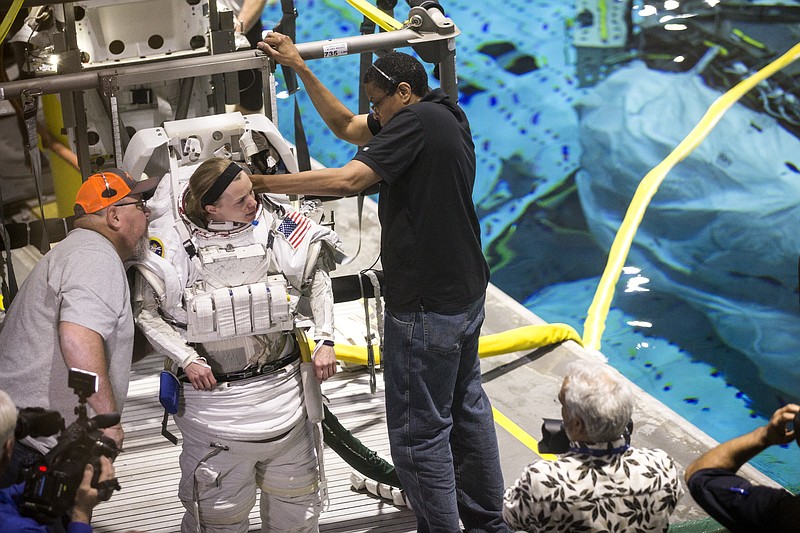HOUSTON (AP) - Zena Cardman shimmied into a white spacesuit beside the 6.2 million-gallon pool, NASA personnel by her side ensuring everything was sealed up tight.
The Houston Chronicle reported it was barely 8:30 a.m., but the bright-eyed Cardman was prepping to spend up to eight hours in the pool, known as the Neutral Buoyancy Laboratory, as part of her training to be an astronaut.
At least 20 feet above her in the visitor's gallery, a group of high school students - usually quick to moan at such an early hour - were just as bright-eyed as they watched the newbie astronaut suit up.
They had a perfect view of what is much more difficult to see at ground level: Within the 40-foot-deep pool sat a mock-up of the International Space Station, providing astronauts a training ground for spacewalks because of the environment's likeness to zero gravity.
One especially giddy boy watched in wonder as the process unfolded.
"I'm applying," he said.
It's exactly the reaction officials hoped for from students at Space Center University, a five-day program at Space Center Houston that was recently expanded to include middle school as well high school students.
Similar to Space Camp in Alabama, students are exposed to the rigors of astronaut training, as well as science, technology, engineering and math fields that could land them a job at NASA one day. They conduct experiments, go behind the scenes at the Johnson Space Center and even get a chance to scuba dive.
The program, started in 2000, brings students from around the world to Houston each year. With the expansion to middle school students, participation in the program has almost doubled to 2,000 so far this year.
"It's exciting to see the growth of the program," said Kaci Heins, the education manager at Space Center Houston's museum. "We're trying to inspire the next generation of explorers early on by showing them this is exactly what they do across the street."
Space Center Houston, typically teaming with visitors speaking countless different languages, was a ghost town when the group of 36 high school students from Great Britain and France recently strolled up to its front doors.
It was the group's fourth of five days participating in the program, and so far they'd built mini-Mars habitats, a launchable rocket and a cryo-capsule to protect egg-stronauts - astronauts made of eggs - from minus-321 degrees, a similar temperature to what astronauts would experience on Mars.
It was only 7:30 a.m., but there was not a yawn in sight as the students prepared for arguably the most exciting of the five-day program. This day, they were getting a crash course in scuba diving, a key component for participants 15-18.
The diving experience is the best way to show them what it's like to be an astronaut - which is the goal of the whole program, said Dave Brown, program coordinator.
Initially, the five-day program was limited to students ages 15-18 and available 50 weeks of the year, though officials usually fill only 26-28 weeks. The programs for 11- to 14-year-olds were added this year with activities tailored to a younger audience.
Along with building rockets, habitats and scuba diving, students also meet an astronaut and tour NASA's Houston facilities, such as Mission Control and the Neutral Buoyancy Laboratory.
Emily Rowe, an 18-year-old from Great Britain who participated in the early April group, found the STEM activities most beneficial. She dreams of being a mechanical engineer after college, and the program "is just another STEM building block on the path toward my goal," she said.
Depending on the number of students enrolled each week and whether hotel, transportation and food is included, the cost of the program ranges from $616-$1,046. Students can apply in groups or as individuals on the museum's website. Some scholarships are available.
"We're trying to inspire them ever earlier on, so they can learn what courses to take in high school and show them the pathway so then they're on their way," Heins said.
Even in early April, the air in the Williams Pool building was thick with humidity and chlorine.
The aluminum walls were rusting, the paint was peeling, and the bleachers were old and crumbling. The pool had clearly seen decades of use.
However, it doesn't have to be pretty to help scuba-certify the men and women headed to space. NASA has been using William's Indoor Pool, about a 20-minute drive from the Johnson Space Center, as a training ground for astronauts since 2008. Each astronaut must be a certified scuba diver so they can practice spacewalks in the Neutral Buoyancy Laboratory.

